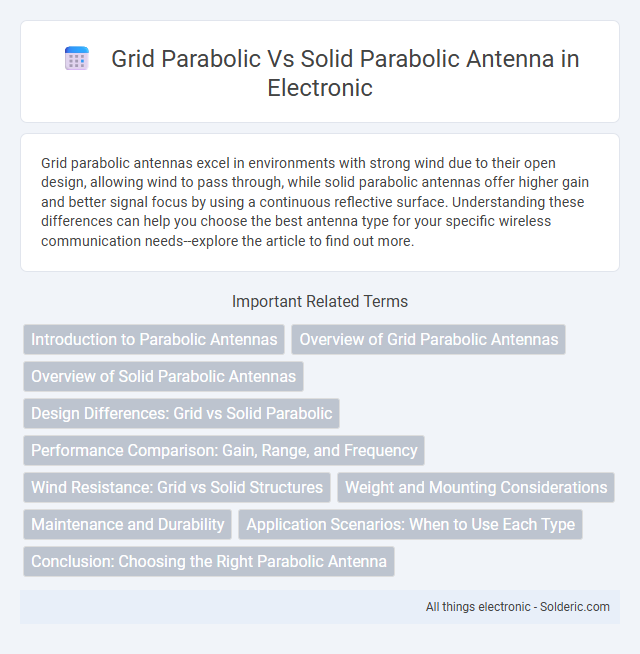Grid parabolic antennas excel in environments with strong wind due to their open design, allowing wind to pass through, while solid parabolic antennas offer higher gain and better signal focus by using a continuous reflective surface. Understanding these differences can help you choose the best antenna type for your specific wireless communication needs--explore the article to find out more.
Comparison Table
| Feature | Grid Parabolic Antenna | Solid Parabolic Antenna |
|---|---|---|
| Material | Metal grid reflector | Solid metal or plastic reflector |
| Wind Resistance | High, less wind load | Lower, more wind load |
| Weight | Lighter | Heavier |
| Signal Gain | Moderate to high gain | High gain, better signal focus |
| Durability | Durable, corrosion-resistant | Highly durable, robust construction |
| Best Use | Outdoor, windy environments, Wi-Fi & microwave links | High-performance links, satellite TV, long-distance communication |
| Cost | Generally lower | Generally higher |
Introduction to Parabolic Antennas
Parabolic antennas, widely used in wireless communication and satellite systems, feature a reflector shaped like a paraboloid to focus signals to a specific point, enhancing signal strength and directionality. Grid parabolic antennas employ a mesh reflector design that reduces wind resistance and weight, making them ideal for outdoor installations in windy environments. Solid parabolic antennas use a continuous reflective surface, providing better signal gain and efficiency, especially at higher frequencies where precision in the reflector shape is critical.
Overview of Grid Parabolic Antennas
Grid parabolic antennas feature a mesh-like reflector composed of metal rods arranged in a grid pattern, which reduces wind resistance and weight compared to solid parabolic antennas. These antennas offer high gain and directional signal focus, making them ideal for long-range wireless communication and outdoor applications where environmental factors are critical. Their design also allows for effective signal reflection while minimizing wind load, enhancing durability in challenging weather conditions.
Overview of Solid Parabolic Antennas
Solid parabolic antennas feature a continuous reflective surface that maximizes signal gain and provides superior directional focus compared to grid parabolic antennas. Their solid construction reduces signal diffraction and is more effective for long-distance communication and high-frequency applications. You benefit from enhanced reliability and improved performance in environments where signal strength and clarity are critical.
Design Differences: Grid vs Solid Parabolic
Grid parabolic antennas feature a mesh-like reflector made of metal rods, enabling reduced wind resistance and lighter weight, making them suitable for outdoor installations in windy environments. Solid parabolic antennas use a continuous reflective surface, typically metal or fiberglass, providing higher gain and better signal focus due to minimal signal diffraction. The design of grid antennas allows for easier cooling and less wind load, while solid parabolic antennas excel in environments demanding maximum signal strength and precision.
Performance Comparison: Gain, Range, and Frequency
Grid parabolic antennas typically offer lower gain and shorter range compared to solid parabolic antennas due to their open mesh design, which reduces wind resistance but slightly decreases signal reflection efficiency. Solid parabolic antennas provide higher gain and longer range by reflecting signals more precisely, making them ideal for higher frequency applications where signal integrity is crucial. Your choice depends on the trade-off between durability in windy environments with grid antennas and superior performance at higher frequencies with solid parabolic designs.
Wind Resistance: Grid vs Solid Structures
Grid parabolic antennas offer superior wind resistance due to their open, lattice-like structure that allows wind to pass through, reducing wind load and the risk of damage during storms. Solid parabolic antennas, while providing better signal reflection and gain, present a larger surface area that catches more wind, making them more susceptible to wind-induced stress and potential structural failure. Your choice should consider local wind conditions, as grid antennas are preferable for high-wind environments to ensure durability and stability.
Weight and Mounting Considerations
Grid parabolic antennas are lighter due to their open-frame design, making them easier to mount on lightweight poles or structures with limited support capacity. Solid parabolic antennas, being heavier and bulkier, require sturdier mounts and more robust installation hardware to ensure stability in harsh weather conditions. Your choice depends on the mounting location and the structural support available for the antenna setup.
Maintenance and Durability
Grid parabolic antennas require less maintenance due to their open structure, which resists wind load and reduces debris accumulation, enhancing durability in harsh weather conditions. Solid parabolic antennas, though more susceptible to wind damage and needing regular cleaning to prevent signal loss from dirt or snow, offer higher gain and better signal focus for long-distance communication. Your choice depends on balancing ease of maintenance with performance needs and environmental factors.
Application Scenarios: When to Use Each Type
Grid parabolic antennas excel in outdoor environments requiring high wind resistance, making them ideal for long-distance Wi-Fi links and point-to-point communications in rural or coastal areas. Solid parabolic antennas offer superior signal gain and weather protection, suited for urban settings or applications demanding maximum signal strength and minimal interference. Choose a grid parabolic antenna for durability in harsh weather and your solid parabolic antenna when optimal signal clarity is essential.
Conclusion: Choosing the Right Parabolic Antenna
Grid parabolic antennas offer superior wind resistance and reduced weight, making them ideal for high-wind environments and long-distance wireless communication. Solid parabolic antennas provide better signal focus and higher gain, which benefits applications requiring maximum signal strength and minimal interference. Your choice depends on environmental conditions and performance needs, with grid antennas suited for outdoor robustness and solid antennas optimized for focused signal reception.
grid parabolic vs solid parabolic antenna Infographic

 solderic.com
solderic.com